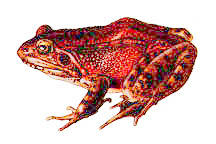Six widely used pesticides will be evaluated by the U.S. Fish and Wildlife Service over the next two years to determine whether they are being properly regulated to avoid having them contribute to the extinction of the California red-legged frog.The pesticides that will be evaluated are glyphosate, malathion, simazine, pendimethalin, permethrin, methomyl and myclobutanil. Glyphosate, an herbicide, is known by the brand name RoundUp and is among the world's most widely used pesticides. The agency agreed to look at the effects of the pesticides to settle a lawsuit filed three years ago by the Center for Biological Diversity.
The review of the effects of the pesticides, formally called a "consultation" by federal officials, will be one of the first under a recently reformed system for pesticide evaluation by federal agencies that takes effect in 2014.
The National Academy of Sciences Research Committee in a report published at the end of April had recommended reforms to eliminate conflicting risk assessment methods by different agencies. Now, federal evaluations of pesticide risks to species listed under the Endangered Species Act will follow a unified protocol under which they will use recommended scientific "best practices" to evaluate issues, including indirect effects such as whether a pesticide is reducing a listed species' food supply, sub-lethal effects of chemicals that may weaken the species without directly killing it and the effects of combining pesticides with other compounds.
In the case of red-legged frogs, which live in the Sierra foothills including in Calaveras County, the analysis will include issues such as whether pesticides drifting into the foothills from farms miles away in the Central Valley are harming the frogs.
"You can impact these species without being right next to them," said Justin Augustine, an attorney for the Center for Biological Diversity. "That isn't a minor issue," he said. "Drift is a major issue. We definitely expect that to be a central aspect of a biological opinion."
If federal biologists conclude that pesticides drifting from farms near Lodi and Stockton are harming frogs, that, in turn, could mean new restrictions on using the chemicals. Currently, requirements are that pesticide applications must be at least 60 feet from frog habitats.
Source: Recordnet.com, 2 January 2014
http://www.recordnet.com/apps/pbcs.dll/article?AID=/20140102/A_NEWS/401…

- Log in to post comments
